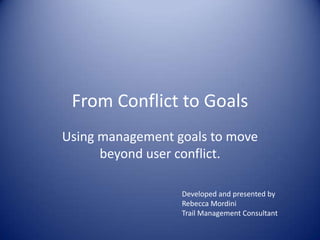Trail User Conflict
This document outlines a framework for shifting trail management discussions from entrenched user conflict to goals-based management. It identifies decades of conflict between various trail user groups and individuals. The current model of focusing on a single user group or prohibiting certain uses has not resolved issues and instead uses data to support each side without progress. The document proposes replacing "problems" with management goals of safety, sustainability, and user satisfaction. It suggests generating solutions based on these goals rather than linking problems to user groups. This shifts responsibility onto individual users to improve their own experience instead of relying on restrictions or other groups. With this framework in place, the community can potentially move past deep-seated conflicts.

















Recommended






















































More Related Content
Similar to Trail User Conflict (20)














































Trail User Conflict
- 1. From Conflict to GoalsUsing management goals to move beyond user conflict.Developed and presented by Rebecca MordiniTrail Management Consultant
- 2. ObjectivesIdentify how trail management goals can be used to move beyond entrenched user conflictProvide a visual framework for the shift from conflict to goals that can be used in policy discussionsLeave all user groups feeling heard and acknowledged
- 3. Trail Management GoalsDecrease RiskReduce ErosionReduce User Conflict
- 4. Diffuse decades of animosity so that we can move forward with trail management goals and objectives.Shift all conversations
- 5. Entrenched ConflictDecades of conflictThe same individuals involved for 20 to 30 yearsPersonal animosity that goes beyond the issuesPlayers are so identified with their position that they cannot be separated
- 6. Our TrailsNarrow, natural surface trailsGrade up to 20% (steep)Multi-use including equestrian, bikes, shuttled bikes, trail runners, hikers, dogsUrban interface areaErosion and maintenance issuesMulti-jurisdictional
- 7. Current ModelFocus on a single solution or user group.ProhibitDirectionRouteTimeHow?Why?Restrict Bicycles ?ProblemsDangerous Cause DamageBad Experience
- 8. Current ModelLinking problems to user groupsRestrict Bicycles ?Dangerous Cause DamageBad ExperienceProConProProConConSurpriseNear missfearFew CoHigh #SpeedNarrowCollissionsEyebrowsTreadSpeedHistorySingle track Other WaterHorseMaintData
- 9. Current ModelRestrict Bicycles ?Dangerous Cause DamageBad ExperienceProConProProConConSurpriseNear missfearFew complaintsLots of usersSpeedNarrowEyebrowsTreadSpeedHistorySingle track WaterHorsesMaintData is used to support problemsData
- 10. But over the years data is inconclusive and ends up being used by both âsidesâ. No progress is made.
- 12. Restrict Bicycles?SafetySustainabilitySatisfactionDangerous Cause DamageBad ExperienceDatabike bellsetiquetteSolutionstrail maintenancerestrict bikessafetysatisfactionsustainability
- 13. Management goals replace problemsSafetySustainabilitySatisfactionDatabike bellsData is used to generate solutions, not problemsetiquetteSolutionstrail maintenancerestrict bikessafetysatisfactionsustainability
- 15. User SatisfactionWhat would make my trail experience better?Apex
- 16. Follow-upUser driven initiatives based on increased satisfactionUser takes responsibility for their own user experience instead of turning to staff or other user groupsDoes not âsolveâ user conflict problems, but makes them irrelevant
- 17. Once a solutions oriented framework is in place, the community can move past entrenched conflict.Email me for more information on how to use this model with your trail user groups.mail@rebeccamordini.com

